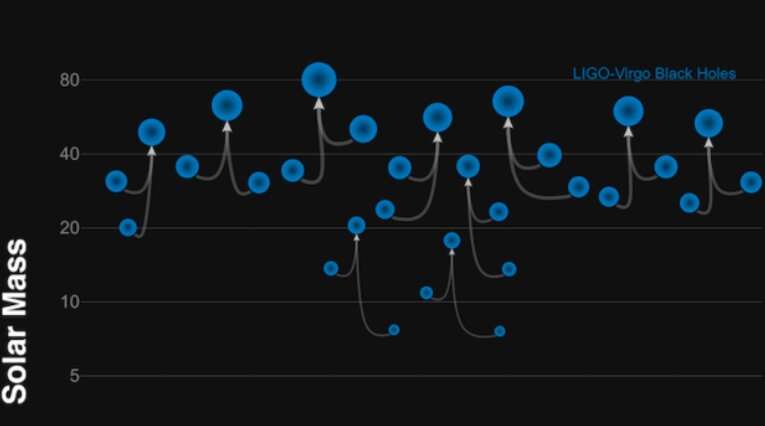For my readers who are also interested in gnostic cosmology, this phase shift would have occurred as the initial correction of the Fall by the aeons of the Fullness...
SEPTEMBER 23, 2019 FEATURE
Theory proposes that LIGO/Virgo black holes originate from a first order phase transition

A few years ago, the LIGO/Virgo collaboration detected gravitational waves arising from a binary black hole merger using the two detectors of the Laser Interferometer Gravitational-Wave Observatory (LIGO). This eventually led to the observation of black holes with masses that are roughly 30 times the mass of the sun. Since then, researchers worldwide have been investigating these black holes, specifically examining whether they could be of primordial origin, meaning that they were produced in the early universe before stars and galaxies were formed.
Hooman Davoudiasl, a theoretical physicist at the Brookhaven National Laboratory in New York, has recently introduced a new theory suggesting that the black holes observed by the LIGO/Virgo collaboration originate from a first order quark confinement phase transition. In his paper, published in Physical Review Letters, Davoudiasl implemented this idea using a light scalar that could turn out to be a good dark matter candidate.
Recent detections by the LIGO/Virgo collaboration suggest that there are several black holes that have similar masses (approximately 30 solar masses). This suggests that there might be a population of black holes that are characterized by a typical mass value.
"This population may be associated with stellar evolution and certain astrophysical conditions, but a primordial origin could also be a potential explanation," Hooman Davoudiasl, the researcher who carried out the study, told Phys.org. "This latter possibility is quite intriguing, but how such objects might form in the early universe is an open question."
A mechanism that could potentially lead to the production of primordial black holes (PBH) is an abrupt cosmological phase transition, which is somewhat similar to the transition from vapor to liquid that occurs when water condenses on a cold surface. An example of this phase transition in the early universe could be the cooling of hot plasma made up of quarks and gluons, which might have occurred as the universe expanded, and they began binding into protons and neutrons.
According to current physics theories, however, there are two key issues with this scenario. Firstly, the transition would not be abrupt, and secondly, it would most likely lead to the production of PBHs with a mass similar to that of the sun, rather than masses 10 or more times larger.
"In my paper, I set out to examine under what additional assumptions, from as yet unknown phenomena, the above picture can change in a way that is conducive to a 'primordial' explanation of the black hole population observed by LIGO/Virgo," Davoudiasl said.
The explanation he proposed is based on a longstanding theoretical construct suggesting that if there are three or more light quarks, the transition from the hot quark-gluon plasma to nuclear particles could, in fact, be abrupt. The current standard physics theory that has been extensively tested, however, states that in this scenario, only two quarks are sufficiently light; thus, the transition would not be abrupt (i.e., it would not be a first-order phase transition).
"My idea was to see how one can arrange for this situation to change in the early universe, so that the transition is abrupt, but then recover the standard picture later on, corresponding to well-established present-day experimental data," Davoudiasl explained.
Davoudiasl essentially wanted to show that under certain conditions corresponding to new physical ingredients, three or more light quarks could, in fact, have been present in the early universe while the transition to nuclear matter was taking place. This would ultimately entail a first-order phase transition, enabling the production of PBH with masses similar to those observed by the LIGO/Virgo collaboration.
"My proposal arranges for the quarks to attain the masses that we observe today afterwards," Davoudiasl said. "However, interestingly, by making the number of light quarks larger, one also pushes the masses of the PBHs that could be produced to larger values, closer to that of the population observed by LIGO/Virgo."
The idea introduced by Davoudiasl in his recent paper could explain the production of the PBHs observed by the LIGO/Virgo team. In addition, it could shed light on why their masses are larger than what might be expected based on current physics theories.
"Rendering the transition abrupt in the way I proposed not only facilitates the production of PBHs, but also makes their expected masses heavier, approaching those observed by LIGO/Virgo through gravitational waves," Davoudiasl added. "Also, my proposal employs a very light hypothetical particle whose dynamics control the variation of quark masses from very small to their observed values today."
Interestingly, the hypothetical "light field" considered in Davoudiasl's theory might have the right properties to be the dark matter of the universe that countless researchers have been investigating and seeking. In fact, the black holes observed by the LIGO/Virgo collaboration may only account for a small fraction of dark matter, due to various constraints.
"The general subject of non-standard cosmologies is worth thinking about further," Davoudiasl said. "Modifying some of our usual assumptions regarding the early universe could potentially lead to new insights about open questions in physics and cosmology."
More information: Hooman Davoudiasl. LIGO/Virgo Black Holes from a First Order Quark Confinement Phase Transition, Physical Review Letters (2019). DOI: 10.1103/PhysRevLett.123.101102
B. P. Abbott et al. Observation of Gravitational Waves from a Binary Black Hole Merger, Physical Review Letters (2016). DOI: 10.1103/PhysRevLett.116.061102
GWTC-1: A gravitational-wave transient catalog of compact binary mergers observed by LIGO and Virgo during the first and second observing runs. arXiv:1811.12907 [astro-ph.HE]. arxiv.org/abs/1811.12907
Journal information: Physical Review Letters
No comments:
Post a Comment
If you leave sincere comments for the blog, you will be answered by the author.